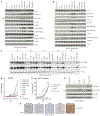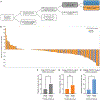Double PIK3CA mutations in cis increase oncogenicity and sensitivity to PI3Kα inhibitors
- PMID: 31699932
- PMCID: PMC7173400
- DOI: 10.1126/science.aaw9032
Double PIK3CA mutations in cis increase oncogenicity and sensitivity to PI3Kα inhibitors
Abstract
Activating mutations in PIK3CA are frequent in human breast cancer, and phosphoinositide 3-kinase alpha (PI3Kα) inhibitors have been approved for therapy. To characterize determinants of sensitivity to these agents, we analyzed PIK3CA-mutant cancer genomes and observed the presence of multiple PIK3CA mutations in 12 to 15% of breast cancers and other tumor types, most of which (95%) are double mutations. Double PIK3CA mutations are in cis on the same allele and result in increased PI3K activity, enhanced downstream signaling, increased cell proliferation, and tumor growth. The biochemical mechanisms of dual mutations include increased disruption of p110α binding to the inhibitory subunit p85α, which relieves its catalytic inhibition, and increased p110α membrane lipid binding. Double PIK3CA mutations predict increased sensitivity to PI3Kα inhibitors compared with single-hotspot mutations.
Copyright © 2019 The Authors, some rights reserved; exclusive licensee American Association for the Advancement of Science. No claim to original U.S. Government Works.
Conflict of interest statement
Figures





Comment in
-
Double trouble for cancer gene.Science. 2019 Nov 8;366(6466):685-686. doi: 10.1126/science.aaz4016. Science. 2019. PMID: 31699922 No abstract available.
References
Publication types
MeSH terms
Substances
Grants and funding
LinkOut - more resources
Full Text Sources
Other Literature Sources
Miscellaneous

